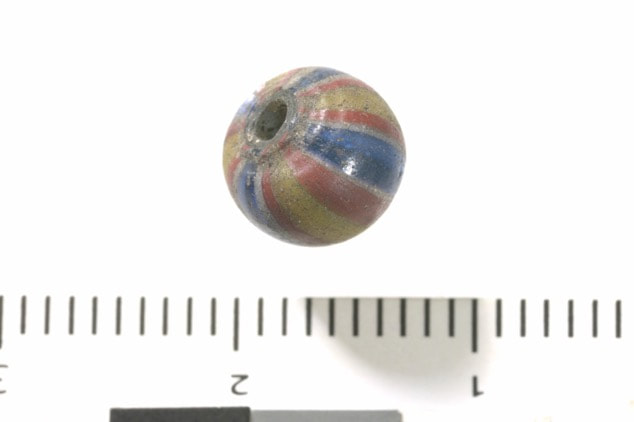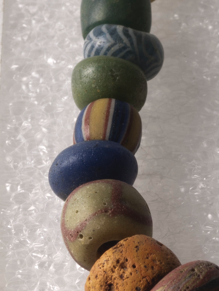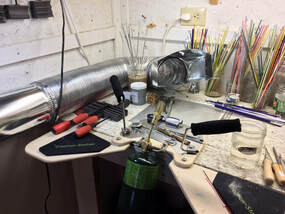When starting out with making beads, most people use what is called "soft glass". This category includes soda-lime glass (the most common) and also lead glass. "Hard glass" is borosilicate glass (Pyrex glass used to be made from borosilicate). Soft glass melts at lower temperatures, making it ideal for those working on a hothead torch (it is also less costly than boro).
When looking at glass suppliers, you will see glass within the Soft Glass category is often noted with a COE number. COE stands for Coefficient of Expansion, is a way of noting how something changes in size with a change of temperature. This is important because you need to make sure that the glasses you are using together will be compatible and the first thing to check is that the COE matches (note, COE alone does not promise that your glass will play well together, some colors just don't want to be friends with others and there is still going to be trial and error involved and it will definitely help to chat with more experienced lampworkers when issues arise). The higher the COE, the "softer" the glass is.
I pretty much only use 104 COE. There are several manufacturers and a very wide range of colors in this category. I do have some 96 COE frit (crushed glass that is used to decorate glass goods) because in small doses it will work with 104, and I bought a few rods of Bullseye (90 COE) because they had colors I needed to test out. I am being careful to keep those rods of glass away from my batches of 104 because mixing the two will most likely result in cracked beads.
With all of that in mind, here are some of the major brands of glass:
Effetre (Moretti): This Italian glass has been around since the Renaissance. I would say 75% of my glass stash at this time is Effetre. It melts easily on my torch, comes in a wealth of colors, and many shops have regular sales on this one which lets me keep my favorite colors in stock. They have all of the basic colors needed for historic beads as well. My favorite vendors for this brand are Mountain Glass, Howaco, Wale Apparatus, and Frantz.
A couple of personal opinions I want to note here about Effetre (your experiences might well differ, and I encourage you to play around as much as possible, with as many colors and brands as possible):
- The white is a clean clear white, even if heated a lot. (Devardi's white smudges up and looks dirty very easily.)
- If you are buying clear for encasing, pay the little bit extra and just go with the Super Clear. It goes on more smoothly and is less prone to looking dirty when over worked.
- My Go-To colors are: Super Clear, White, Black, Cobalt transparent, Pea Green Opaque, Grass Green Transparents, Lapis Opaques, Ivory, Lemon Yellows
- Keep in mind that Black glass is technically a transparent, so you will not find that if you have a filter set to show you only opaque colors.
- Intense Black is a very, very pricey black that can do some very cool webbing effects on certain colors. I would not choose this one for working basic black beads just due to the price (and for the chance that it will web).
- Teals, some greens and some blues have copper in their chemistry. These can very easily reduce on hothead torch and you will get opaque red-brown patches in the glass. Be careful to work these gently and far out in the flame (and do not over work). The cobalt/lapis range of blues and the Grass Green transparents are more forgiving.
- Turquoise and teal glasses can have beautiful effects when used in conjunction with ivory.
- If you are looking for reds/browns/yellows and cannot find them under Effetre Pastels (pastel = opaque), that is because they are often listed as "special" colors.
- Many of the reds will darken the more you work them, and even if they are careful, they can still get darker when they are annealed. Do tests with this color so that you know what you are likely to get in the end.
CIM (Creation is Messy/Messy Glass): CIM glass is made in China and it comes in a pretty wild array of colors. Many of their glasses are translucent or opal, rather than transparent or opaque. Often a rod will yield a bead that has striations of light or darker glass, or that will strike to a slightly different shade than the rod itself. Many of my favorite colors from this manufacturer are less useful for historic reproductions, but still can make incredibly beautiful jewelry. My favorite vendors for this brand are Mountain Glass and Howaco.
- This glass can be a bit more fussy than Devardi and Effetre, and I am glad not that I did not immediately jump in to try it as I could well have found the experience frustrating.
- I absolutely love their range of reds and am particularly fond of Hemoglobin and Sangre.
- I also love their opal, chartreuse greens such as Elixir, Budgerigar, Ectoplasm and Anole. Note that these can be very easily overworked.
- I still have many colors of this brand to sample, but over all, I prefer the more "solid" colors of Effetre for historical applications.
Devardi: I started with Devardi glass, which is produced in India, and still love many of the colors. This is still a "soft" glass, but it tends to be quite stiff compared to some of the others in the 104 category. I actually found this very useful as a beginner because I had time to work the glass without it getting too goopy and dripping right off the mandrel (something that totally happened to me the first time I tried Efftre on a duel fuel torch, lol). The other benefit to this one is that it is very cheap, especially when you buy in bulk. I really do recommend buying one of their bulk lots of random glass and just enjoy playing with when you start out.
- It is definitely worth getting one of their bargain bundles of glass when you are starting out.
- I still love their cobalt blue in particular. It is very stiff and makes for great sculptural items.
- I also still use their amber transparents and the yellow-green transparents frequently.
- Forest Green burns easily, or will get red reduction spots in very short time.
- I do not like their white or clear, and prefer the Effetre in those.
Double Helix: Once you start working with glass you will see this name come up frequently or you will see lampworkers posting their beads with wild iridescent effects. This company makes a range of silver glasses (these are the ones that will have iridescent, pearl or color changing effects) as well as superb clears. These glasses are very pricey, and many of them will not work well (or at all) on a hothead torch. If you want to test the waters, I recommend getting one of their reduction frits to play with first to start learning how to bring out the wonderful metallic effects of their glasses. And if you enjoy encasing, their clears can be life changing (and yes, buy the "seconds" as they are cheaper and wonderful to work with).
A few other random bits of information:
- Glass color can vary from batch to batch, so do not be surprised if you get a redder red or a lighter blue when making a repeat purchase of a color.
- Most of the glass supply companies have regular sales! I HIGHLY encourage you to sign up for their newsletters so that you can plan your purchases around the better sales.
- Turquoise glass, in every brand I have tried, hates to be encased. (I always end up with cracked beads. lol)
- Brilliant pinks and purples are going to be the most pricey glasses out there. Definitely look for sales on these items. You can also use tricks like making a base bead in white (or another color) and encasing it with your pricey glass to use as little of it as possible.
- If you need a certain color and your favorite vendor is out, I recommend browsing the selection at other sites because occasional someone will even still have out-of-production colors!
- There are other brands of glass beyond those I have listed above. I have not had enough experience with them to yet form an opinion but I highly recommend that you get samples of anything that interests you and test them out!
As far as vendors go, Mountain Glass is by far my favorite. The guys there are fantastic at helping you find what you need and letting you know immediately if something is out of stock. They also ship very, very quickly. They have soft glass sales every month, as well as a weekly special. They are located in North Carolina, but are preparing to open a West Coast facility this year as well. If you are looking to upgrade a kiln or torch, I very much recommend talking to them, because they will be more than happy to help you figure out what you need (without trying to sell something you don't need). I happily give them my business whenever possible.
Howaco has the best non-sale prices on Effetre that I have found anywhere. Her prices are extremely good at all times. Another bonus of this vendor is that you can buy a single rod of glass so that you can test a color before ordering more. Note that this is a smaller shop, so that it can take a little more time for her to process and ship your order (especially if you are ordering a ton of single rods, as each has to be labeled before being packaged up).
Devardi is my staple for inexpensive tools and certain colors of glass (as well as bundles of cheap glass for dabbling). They also have excellent customer service and very quick shipping.




 RSS Feed
RSS Feed